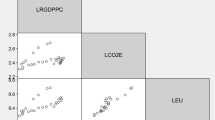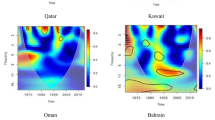Abstract
This paper reports the results of a study that investigates the causal interactions among the entities energy consumption, democracy, income, and CO2 emissions in Bangladesh. Bootstrapping causality and time–frequency domain causality methods were adopted to examine the causal co-movements between the variables, using data series for a period of more than four decades. Results show that time-scale behavior plays an important role. Democracy is an important factor for emissions and national income. The nexus of democracy and CO2 emission is bidirectional. The impact of democracy on CO2 is stronger than vice versa. This study provides new insights for policymakers: democratic practices play an important role in implementing climate change policies, at least in the case of Bangladesh.

Source: All time series are collected from WDI on-line database (World Bank), except Democracy data collected from Freedom House. Sample period: 1972–2010


Source: Data for GDP: log of Real GDP (Gross Domestic Product) per capita, CO2: Log of Carbon dioxide emission per capita, Energy: log of energy use (KWh) per capita, are collected from WDI on-line database (World Bank), except Democracy data collected from Freedom House. Sample period: 1972–2010
Similar content being viewed by others
Notes
Government of the People’s Republic of Bangladesh: National Adaptation Programme of Action [19].
World Development Indicator, World Bank. Summary statistics is available on request.
Bangladesh Development Initiative [2].
The application of this approach provides accurate inference in the presence of the ARCH effects, and the goal of the VAR model is to conduct ex ante inference.
The optimal lag order k is determined by minimizing an information criterion suggested by Hatemi-J [26].
Where \( \beta = vec(D) \) and vec is the column-stacking operator; the notation ⊗ represents the Kronecker product and C is a (p×n)(1 + p×n) indicator matrix with elements consisting of ones and zeros. The unrestricted VAR model, denoted by SU, is defined as \( {\mathbf{S}}_{U} = \frac{{\hat{\varepsilon }_{U}^{{\prime }} \hat{\varepsilon }_{U} }}{T - b} \), where b is the number of estimated parameters and the Wald statistic follows a χ2 distribution asymptotically with p degrees of freedom.
See Bekiros and Marcellino [3] for details.
For I(1) variables see Breitung and Candelon [5].
References
Arrow, K., Bolin, B., Costanza, R., Dasgupta, P., Folke, C., Holling, C.S., Jansson, B., Levin, S., Mäler, K., Perings, C., Pimentel, D.: Economic growth, carrying capacity, and the environment. Ecol. Econ. 15, 91–95 (1995)
Bangladesh Development Initiative, six-point policy—priorities for Bangladesh: 2009–2013, http://www.bdiusa.org/six-point-policy-priority-bangladesh (2009). Accessed 30 Apr 2015
Bekiros, S., Marcellino, M.: The multiscale causal dynamics of foreign exchange markets. J. Int. Money Finance 33, 282–305 (2013)
Bernauer, T., Koubi, V.: Effects of political institutions on air quality. Ecol. Econ. 68(5), 1355–1365 (2009)
Breitung, J., Candelon, B.: Testing for short and long-run causality: a frequency domain approach. J. Econom. 132, 363–378 (2006)
Chadwick, B.P.: Fisheries, sovereignties and red herrings. J. Int. Αffairs 48(2), 559–584 (1995)
Dasgupta, P., Mäler, K.-G.: Poverty, institutions and the environmental resource-base. In: Behrman, J., Srinivaan, T.N. (eds.) Handbook of development economics, vol. 3A. Elsevier Science, Amsterdam (1995)
Deacon, R.: The political economy of environment-development relationships: a preliminary framework. FEEM Working Paper No. 3.00. http://ssrn.com/abstract=229005 (2000)
Desai, U.: Environment, economic growth, and government. In: Desai, U. (ed.) Ecological policy and politics in developing countries. State University of New York Press, Albany (1998)
Dickey, D.A., Fuller, W.A.: Likelihood ratio statistics for autoregressive time series with a unit root. Econometrica, 1057–1072 (1981)
Farzin, Y.H., Bond, C.A.: Democracy and environmental quality. J. Dev. Εcon. 81(1), 213–235 (2006)
Finance Division. Bangladesh economic review. Annual Review. Ministry of Finance, Bangladesh Government. http://www.mofgov.bd/en/index.php?option=com_content&view=article&id=367&Itemid=1 (2016). Accessed 29 Jul 2017
Fredriksson, P.G., Neumayer, E.: Democracy and climate change policies: is history important? Ecol. Econ. 95, 11–19 (2013)
Fredriksson, P.G., Neumayer, E., Damania, R., Gates, S.: Environmentalism, democracy, and pollution control. J. Environ. Econ. Manag. 49(2), 343–365 (2005)
Freedom House: Freedom in the world. www.freedomhouse.org/ratings/index.htm (2011)
Geweke, J.: Measurement of linear dependence and feedback between multiple time series. J. Am. Stat. Assoc. 77, 304–324 (1982)
Goel, K., Herrala, R., Mazhar, U.: Institutional quality and environmental pollution: MENA countries versus the rest of the world. Econ. Syst. 37(4), 508–521 (2013)
Government of the People’s Republic of Bangladesh: National Adaptation Programme of Action (NAPA). http://unfccc.int/resource/docs/napa/ban01.pdf (2005). Accessed 10 Aug 2017
Granger, C.W.J.: Investigation causal relations by econometric models and cross-spectral methods. Econometrica 37, 424–438 (1969)
Green Alliance: Paris (2015)—getting a global agreement on climate change (2014)
Gronwald, M.: Reconsidering the macroeconomics of the oil price in Germany: a testing for causality in the frequency domain. Empir. Econ. 36, 441–453 (2009)
Grossman, M., Krueger, A.: Economic growth and the environment. Q J Econ 110(2), 353–377 (1995)
Hacker, R.S., Hatemi-J, A.: Tests for causality between integrated variables using asymptotic and bootstrap distributions: theory and application. Appl. Econ. 38, 1489–1500 (2006)
Hatemi, J.A., Uddin, G.S.: Is the causal nexus of energy utilization and economic growth asymmetric in the US? Econ. Syst. 36(3), 461–469 (2012)
Hatemi-J, A.: A new method to choose optimal lag order in stable and unstable VAR models. Appl. Econ. Lett. 10, 135–137 (2003)
Heerink, N., Mulatu, A., Bulte, E.: Income inequality and the environment: aggregation bias in environmental Kuznets curves. Ecol. Econ. 38(2), 359–367 (2001)
Houghton, J.T., Callander, B.A., Varney, S.K.: Climate change 1992. Cambridge University Press, Cambridge (1992)
Intergovernmental Panel on Climate Change: Working Group III Report: Mitigation of Climate Change. http://www.ipcc.ch/publications_and_data/ar4/wg3/en/contents.html (2007)
IPCC: Climate Change 2014: impacts, adaptation, and vulnerability. Part A: global and sectoral aspects. In: Field, C.B., Barros, V.R. (eds.) Contribution of working group II to the fifth assessment report of the intergovernmental panel on climate change, pp. 1–32. Cambridge University Press, New York (2014)
Johansen, S.: Likelihood-Based Inference in Cointegrated Vector Auto-regressive Models. Oxford University Press Inc., New York (1995)
Kuznets, S.: Economic growth and income inequality. Am. Econ. Rev. 45, 1–28 (1955)
Lau, L.-S., Choong, C.-K., Eng, Y.-K.: Carbon dioxide emission, institutional quality, and economic growth: empirical evidence in Malaysia. Renew. Energy 68, 276–281 (2014)
MacKinnon, J.G., Haug, A.A., Michelis, L: Numerical distribution functions of likelihood ratio tests for cointegration. J. Appl. Econometrics. 14, 563–577 (1999)
Midlarsky, M.I.: Democracy and the environment: an empirical assessment. J. Peace Res. 35(3), 341–361 (1998)
Neumayer, E.: Do democracies exhibit stronger international environmental commitment? A cross-country analysis. J. Peace Res. 39(2), 139–164 (2002)
Olson, M.: Dictatorship, democracy and development. Am. Polit. Sci. Rev. 87(3), 567–576 (1993)
Ozturk, I.: A literature survey on energy-growth nexus. Energy Policy 38, 340–349 (2010)
Pachauri, R.K., Allen, M.R., Barros, V.R., Broome, J., Cramer, W., Christ, R., Dubash, N.K.: Climate change 2014: synthesis report. Contribution of Working Groups I, II and III to the fifth assessment report of the Intergovernmental Panel on Climate Change, IPCC, p. 151 (2014)
Panayotou, T.: Demystifying the environmental Kuznets curve: turning a black box into a policy tool. Environ. Dev. Econ. 2, 465–484 (1997)
Payne, R.A.: Freedom and the environment. J. Democr. 6(3), 41–55 (1995)
Phillips, P.C., Perron, P.: Testing for a unit root in time series regression. Biometrika 75, 335–346 (1988)
Roberts, J.T., Parks, B.C.: A climate of injustice: global inequality, north-south politics, and climate policy. MIT Press, Cambridge (2007)
Romuald, K.S.: Democratic institutions and environmental quality: effects and transmission channels. In 2011 International congress, August 30–September 2 2011, Zurich, Switzerland (No. 120396), European Association of Agricultural economists (2011)
Scruggs, L.A.: Political and economic inequality and the environment. Ecol. Econ. 26(3), 259–275 (1998)
The World Bank: Bangladesh: bolstering economic growth to reduce poverty. http://web.worldbank.org/WBSITE/EXTERNAL/NEWS/0,,contentMDK:22888421~menuPK:141311~pagePK:34370~piPK:34424~theSitePK:4607,00.html (2015). Accessed 24 Apr 2015
Tiwari, A.K.: The asymmetric Granger-causality analysis between energy consumption and income in the United States. Renew. Sustain. Energy Rev. 36, 362–369 (2014)
Tiwari, A.K.: The frequency domain causality analysis between energy consumption and income in the United States. Economia Aplicada 18(1), 51–67 (2014)
Torras, M., Boyce, J.K.: Income, inequality, and pollution: a reassessment of the environmental Kuznets curve. Ecol. Econ. 25(2), 147–160 (1998)
United Nations Development Programme, About Bangladesh, http://www.bd.undp.org/content/bangladesh/en/home/countryinfo/ (2015). Accessed 29 Apr 2015
Winslow, M.: Is Democracy Good for the Environment? J. Environ. Planning Manage. 48(5), 771–783 (2005)
World Bank: Bangladesh—country snapshot. Country Report, World Bank, Washington, D.C. http://documents.worldbank.org/curated/en/654391476782032287/Bangladesh-Country-snapshot 2016. Accessed 29 Jul 2017
World Bank: Bangladesh: ensuring a reliable and quality energy supply. Media report. http://www.worldbank.org/en/results/2016/10/07/bangladesh-ensuring-a-reliable-and-quality-energy-supply 2017. Accessed 29 Jul 2017
You, W.-H., Zhu, H.-M., Yu, K., Peng, C.: Democracy, financial openness, and global carbon dioxide emissions: heterogeneity across existing emission levels. World Dev. 66, 189–207 (2015)
Author information
Authors and Affiliations
Corresponding author
Rights and permissions
About this article
Cite this article
Ahmed, A., Bekiros, S., Rosklint-Lindvall, E. et al. The influence of energy consumption and democratic institutions on output and CO2 emissions in Bangladesh: a time–frequency approach. Energy Syst 11, 195–212 (2020). https://doi.org/10.1007/s12667-018-0309-5
Received:
Accepted:
Published:
Issue Date:
DOI: https://doi.org/10.1007/s12667-018-0309-5




